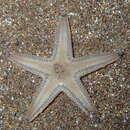pt-BR
nomes no trilho de navegação


Astropecten jonstoni is a sea star of the family Astropectinidae.
Starfishes of genus Astropecten live on mobile seabed (sandy, muddy or gravel seabed) and they remain largely buried under sediment during the day. During the late afternoon and the night starfishes go out to hunt mainly bivalve molluscs, which are their favourite preys. Unlike other Astropecten, this species is active and easy to find during day, especially in early morning and late afternoon. This species lives only in the Mediterranean Sea and it prefers sandy seabed at low depths as between 1 and 12 m.
This sea star has superomarginal plates with a very short spines or without spines (usually the plates between the arms are devoid of spines). The inferomarginal plate has a short and pot external spine, arranged with great regularity, normally kept parallel to one another and rather rigid. The inferomarginal spines have dark orange colour at the base and white-yellowish towards the tip on going to draw a sort of orange outline at the base of the sea star. The overall shape is very peculiar with bigger disc than other species and arms rather court, triangular and very pointed that accentuates the classic shape of the star. The colour of aboral side is pretty clear with various nuances that can be tending towards beige, turquoise-green or grey-brown. It is the smallest species of Astropecten in the Mediterranean Sea with a maximum diameter of about 7–8 cm. This starfish has a lot of features and can be distinguished easily by its overall shape, size and colour. Rarely it is confused with very young specimens of Astropecten platyacanthus.
This sea star is a carnivore and feeds on molluscs, which it catches with its arms and then takes to the mouth. The prey is then trapped by the long, moving prickles around the mouth cavity.
Astropecten jonstoni is a sea star of the family Astropectinidae.
Astropecten jonstoni (Delle Chiaje, 1825) è una stella marina della famiglia Astropectinidae.
Endemica del Mar Mediterraneo, vive su tutti i fondali mobili (sabbiosi, fangosi o ghiaiosi) ma predilige i fondali sabbiosi da 1 a 12 m circa di profondità.
Questa stella ha le placche marginali dorsali con un aculeo molto corto o assente (di norma le placche fra le braccia sono prive di aculei). Le placche marginali ventrali hanno un aculeo esterno abbastanza corto e piatto. Gli aculei delle placche marginali ventrali sono disposti con molta regolarità, tenuti di norma paralleli fra loro e piuttosto rigidi. Essi hanno la base di colore arancione scuro e la punta bianco-giallastro andando a disegnare una sorta di contorno arancione alla base della stella. La forma complessiva è molto peculiare con un disco più grande rispetto alle altre specie e braccia piuttosto corte, triangolari e molto appuntite che ne accentuano la classica forma di stella. Il colore del lato aborale è in genere abbastanza chiaro con sfumature varie che possono essere tendenti al beige, al verdastro-turchese o al grigio-bruno.
È una stella che ha caratteristiche molto costanti e si può distinguere facilmente anche solo dalla sua forma complessiva.
Le stelle del genere Astropecten di norma sono attive prevalentemente di notte e nelle tarde ore pomeridiane mentre durante il giorno vivono infossate nel sedimento. Questa specie, invece, è attiva prevalentemente nelle ore diurne e la si può incontrare nei bassi fondali anche in pieno giorno.
Nel Mediterraneo vivono altre cinque specie di Astropecten: Astropecten aranciacus, Astropecten irregularis, Astropecten bispinosus, Astropecten spinulosus, Astropecten platyacanthus.
Astropecten jonstoni (Delle Chiaje, 1825) è una stella marina della famiglia Astropectinidae.
Astropecten jonstoni est species stellarum marinarum familiae astropectinidarum.
Astropecten jonstoni est species stellarum marinarum familiae astropectinidarum.
Astropecten jonstoni is een kamster uit de familie Astropectinidae.
De wetenschappelijke naam van de soort werd in 1827 gepubliceerd door Stefano Delle Chiaje.
Bronnen, noten en/of referenties